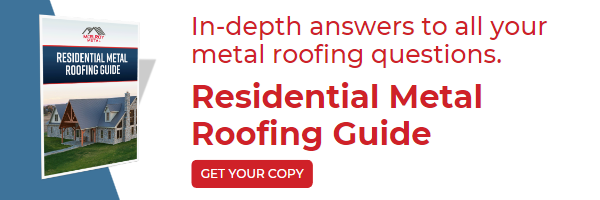Metal Roof Condensation, Insulation, and Vapor Barriers
Condensation can occur within a metal roof system and cause corrosion or mold. Fortunately, if it's addressed before damage occurs, condensation can be addressed easily and cost-effectively. So the best time to discuss condensation is with your architect during the initial roof design or with your contractor if considering a roof replacement.
Not sure what condensation is or how to stop it? Let us start with the basics.
What is Condensation?
If you’ve ever sat outside on a hot summer day with a glass of iced tea and watched as the outside of your glass grew moist and then a puddle formed, you’ve experienced condensation.
The science behind condensation is not overly complicated. When warm moist air comes in contact with a cold surface, the air reaches a temperature near the cold surface where the air can no longer hold the moisture. When the warm air can no longer retain its moisture, the moisture is deposited on the cool surface.
The same principle applies to your home. When the air inside your home is warmer than the air outside, and the roof system isn't properly ventilated, condensation can occur.
Why is Metal Roof Condensation an Issue?
If condensation occurs inside a roof system, it may not be able to evaporate quickly enough before it begins to cause damage. This damage could be in the form of either premature corrosion or mold.
How Do You Control Condensation? Insulation and a Vapor Barrier
To control condensation it's important to ventilate and/or insulate your roofing system properly. Areas like attic spaces and gaps between the ceiling and roof deck (or plywood) are common areas of focus.
If insulating, a vapor barrier should be applied on the warm side to prevent warm moist air from penetrating and coming in contact with the cold surface. Then the entire space should be filled with insulation. If ventilating, the system should be designed to allow proper air flow to remove the warm moist air from inside the space. This can be accomplished through soffit and ridge vents. The ridge vents may be powered vents or they may not, depending on the number of air changes needed.
Should You Be Concerned?
Yes, you should be concerned about condensation because when unresolved, condensation can wreak havoc on your roof system and even cause damage to your interior space.
However, when addressed early the fixes are relatively easy, inexpensive and can even help reduce heating and cooling costs. The best way to stop condensation is to prevent it during the design phase of your roofing project.
Learn More
Contact us for help or use or our locator to find a McElroy Metal Distributor or Contractor near you. Be sure to check out our FAQ about Residential Metal roofing.
About McElroy Metal
Since 1963, McElroy Metal has served the construction industry with quality products and excellent customer service. The employee-owned components manufacturer is headquartered in Bossier City, La., and has 14 manufacturing facilities across the United States. Quality, service and performance have been the cornerstone of McElroy Metal’s business philosophy and have contributed to the success of the company through the years. As a preferred service provider, these values will continue to be at the forefront of McElroy Metal’s model along with a strong focus on the customer.




.png?width=767&name=Metal%20Roofing%20for%20Event%20Centers,%20Arenas%20%20&%20Sports%20Facilities%20(1).png)

.png?width=767&name=Barndominiums%20and%20Shouses%20Designing%20for%20Modern%20Living%20with%20Metal%20Components%20(1).png)



Comments on this article:
Scroll down to the bottom to submit a comment and join the conversation. Need help or have a question? Please contact us. Looking for a distributor or contractor? Please click here to get started.